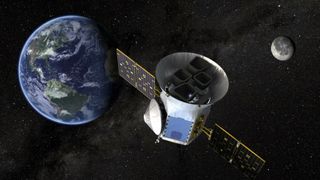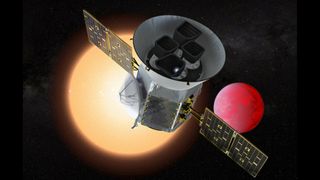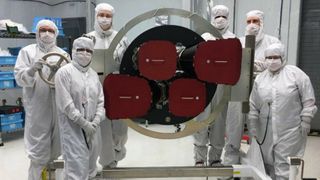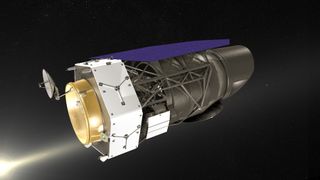How NASA's new planet-hunter will search for Earth 2.0
TESS signals a new era in exoplanet research

Image credit: NASA
Forget exploring the solar system, finding distant galaxies, and even interstellar travel.
If you're an astronomer on the absolute cutting-edge of science and technology, you try to answer one question only: is there an Earth 2.0?
Until 25 years ago we didn't know of any other planets anywhere in the universe. Thanks largely to the Kepler Space Telescope, astronomers now know of over 3,500 exoplanets between 300 and 3,000 light-years away.
By 2020 that's expected to reach as many as 20,000 thanks to TESS – the Transiting Exoplanet Survey Satellite – which is due to launch into space atop a SpaceX Falcon 9 rocket from Cape Canaveral, Florida on April 16, 2018.
What will TESS do?
TESS will find many more exoplanets, and, crucially, much more about them than Kepler was able to do.
Based on what Kepler discovered going around about 150,000 stars in a very small area of our own Milky Way galaxy, astronomers estimate that there could be 100 billion exoplanets out there.
Get daily insight, inspiration and deals in your inbox
Get the hottest deals available in your inbox plus news, reviews, opinion, analysis and more from the TechRadar team.
So TESS is only going to look at stars in our stellar neighborhood, and specifically for planets going around them in the habitable zone.

Planned for over a decade by the Massachusetts Institute of Technology (MIT) – originally using seed funding from Google – TESS is expected to find dozens of Earth 2.0 candidates.
For the first time, astronomers will get accurate data on the sizes, masses and ages of Earth-like worlds.
“We expect TESS will discover a number of planets whose atmospheric compositions hold potential clues to the presence of life, which could be precisely measured by future observers," says George Ricker, TESS principal investigator at MIT's Kavli Institute for Astrophysics and Space Research in Cambridge, which is leading the mission.
What's wrong with Kepler?
Although exoplanets are still being identified from the huge data-set collected by Kepler – not least by Google's AI team – the famously successful planet-hunter lost its edge in 2013 when its motors were damaged, and it could no longer orientate itself.
Although it's been using its 1.4-metre mirror and 95-megapixel camera to make valuable observations more randomly since then, it's due to run-out of fuel later this year.

Importantly, Kepler had a very specific way of looking for exoplanets in its first phase; it stared at one small patch of the sky near the constellation of Lyra.
TESS has a different strategy; it's going to study the whole sky.
Where will TESS search for exoplanets?
During its initial two-year exoplanet-hunting mission, TESS will look at stars less than 300 light-years away and 30 to 100 times brighter than Kepler’s targets.
Their light can help astronomers determine a planet’s mass, density and atmospheric composition, and whether there's any water in its atmosphere.
TESS will split the sky into two areas – south for the first year and north for the second year – and splice each area into 13 sectors.
TESS will look at each sector in turn, for 27 days each, in the hope of capturing transiting planets. In total, TESS will study 85% of the sky, which is about 350 times more sky than Kepler looked at.
What tech will TESS use?
Its immense vision is down to four incredible cameras. Each ultra-wide angle camera has seven lenses to bring the stars into focus, can see a 24 degree-wide square of sky, and has a 16.8-megapixel detector behind it.

"CCDs that you can go out and buy are very thin, just two or three microns," says Ricker. "The TESS CCDs are 100 microns thick so they can get detect near-infrared light (and) they're about 100 times better than the one in your iPhone."
Sitting in a high-Earth, highly elliptical orbit where it could stay stable for a decade, when TESS swings past Earth every 13.7 days it will begin a three-hour downlink of all of its data to the NASA Deep Space Network.
How will TESS identify exoplanets?
TESS will find exoplanets via the transit method, which is exactly how Kepler worked.
When a planet passes in front of its star, it causes a periodic and regular dip in the star’s brightness, which TESS will detect.
There are 100 stars within 20 light years of Earth that likely have planets
TESS project manager Jeff Volosin
However, there is one huge limiting factor on what TESS, and any orbiting space telescope, can see: line of sight.
All planets in a solar system's orbit are generally on the same plane as one another, but TESS will only ever find exoplanets whose orbits happen to be perfectly aligned with its point of view.
Will TESS and the JWST work together?
Data-wise, they will. Although it's going to be able to take a deeper look at exoplanets that ever before, TESS will largely compile an interstellar to-do list for the much more advanced US$8 billion James Webb Space Telescope (JWST) to take a closer look at.
"The JWST is a very large telescope with a set of mirrors 6.5m across, so it's capable of capturing much more light than TESS," says Paul Hertz, director, Astrophysics Division at NASA Headquarters in Washington. "The JWST has spectrometers that can split-up the light and see what kinds of gases are in the atmospheres of planets."

When the JWST was first conceptualized, not a single exoplanet had been discovered. However, the planned match-up between TESS and JWST took a knock recently when JWST had its launch date pushed back from June 2019 to 2020.
Planet-hunters of the future
If TESS is going to create a 'to do list' of targets for JWST, what comes next in the search for Earth 2.0?
The answer is PLATO (Planetary Transits and Oscillations of stars), 'an array of 26 small telescopes that the European Space Agency plans to launch in 2026. On its four or eight year mission while orbiting 1.5 million km beyond Earth, PLATO will focus on finding Earth-sized planets and super-Earths orbiting Sun-like stars in the habitable zone. It will measure the radii, masses and ages of planets, and even study seismic activity in their host stars.

After PLATO will come the next great space telescope, the US$3.2 billion-plus WFIRST (Wide Field Infrared Survey Telescope).
Intended as the successor to the JWST and tentatively planned to launch in the mid-2020s (if it's not cancelled), WFIRST will have an advanced coronagraph that can study nearby exoplanets.
For planet-hunters, the next decade will be all about TESS, but the consequences of its findings may prove far more long-lasting.
"There are 100 stars within 20 light years of Earth that likely have planets," says Jeff Volosin, TESS project manager, NASA’s Goddard Space Flight Center, Greenbelt, Maryland. "If robotic missions could travel at 20% of the speed of light, something that might be possible by the 22nd century, there's a high probability that many of the stars and planets that will be targeted will be those that TESS is about to find."
Jamie is a freelance tech, travel and space journalist based in the UK. He’s been writing regularly for Techradar since it was launched in 2008 and also writes regularly for Forbes, The Telegraph, the South China Morning Post, Sky & Telescope and the Sky At Night magazine as well as other Future titles T3, Digital Camera World, All About Space and Space.com. He also edits two of his own websites, TravGear.com and WhenIsTheNextEclipse.com that reflect his obsession with travel gear and solar eclipse travel. He is the author of A Stargazing Program For Beginners (Springer, 2015),

